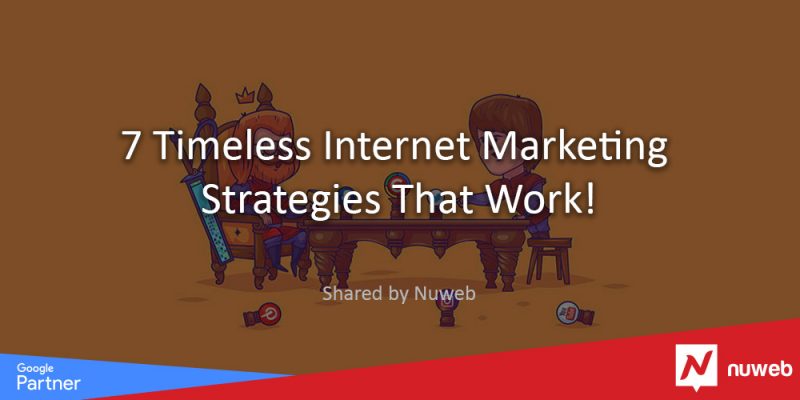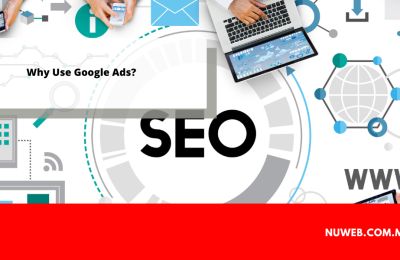But here’s the problem: online marketing can seem quite daunting and complicated. This can deter even the most focused of entrepreneurs from ever implementing an online marketing plan.
That’s why the goal of this article is to dissect internet marketing into its most basic strategies. Then simplify those strategies for the business owner or marketer who hasn’t quite wrapped his or her head around them yet.
I tried only to include “timeless” strategies (i.e. strategies that work and will likely continue to work in the future) so you don’t waste your time learning about little hacks that will quickly die off.
You’ll also notice that there are seven overarching strategies. Then below each strategy, there are various tactics related to that strategy.
Let’s begin!
Content Marketing
Content is the backbone of the internet. If you think about it, nearly everything you view online is content (e.g. videos, articles, blog posts, infographics, etc.) of some kind.
Here’s Google’s definition of content marketing:
A type of marketing that involves the creation and sharing of online material (such as videos, blogs, and social media posts) that does not explicitly promote a brand but is intended to stimulate interest in its products or services.
Content marketing is arguably one of the most important internet marketing strategies because, without it, many other strategies wouldn’t exist (or wouldn’t be effective).
Here are two primary reasons why content—and marketing that content—is beneficial for nearly all businesses:
- Content educates potential customers about your product or service. Why would someone pay you for something if they don’t know what they are purchasing? This is the void content fills.
- Content provides an opportunity for you or your business to be a thought leader in your industry. Being a thought leader results in excellent brand exposure and can open up many doors in your specific space.
Below you will find quick summaries of the major content marketing tactics and then links to resources for further reading.
1. Blogging
Having an industry blog and company newsletter can be very helpful in connecting with current and potential customers.
The Ahrefs Blog is an example of an industry‐specific blog, the ultimate aim of which is to entice visitors into purchasing (or at least trying) the Ahrefs’ software suite. We do this by showing how helpful it is for marketers.
The Ahrefs Product Blog is an example of a blog that covers company and product specific news aimed at informing and communicating with current customers.
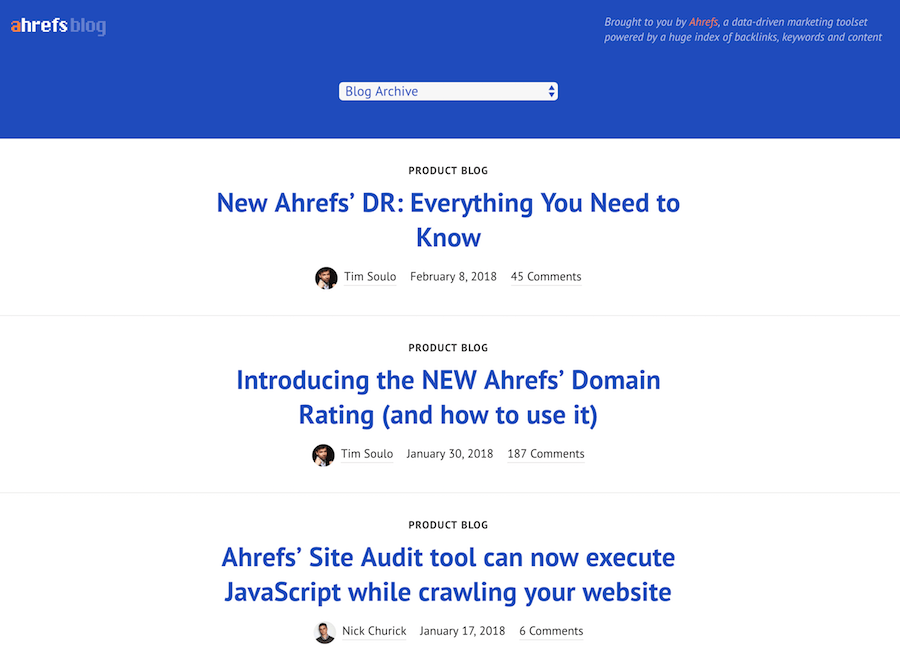
- How to Start a WordPress Blog in Five Minutes: Step by Step
- The Non-Writer’s Guide To Creating “BIG” Blog Content
- Outsourcing Content: Tips, Tricks and Workflows That We Use at Ahrefs
2. “Linkbait” creation (and promotion)
‘Linkbait’ is content that’s specifically formulated to attract links. It’s something so cool, valuable and unique that (given the opportunity) any industry blogger/influencer would be hard‐pressed not to link to it. These links then help to improve the site’s rankings in search engines.
It can be pretty much any form of content (e.g. video, infographic, blog post, long‐form guide, SlideShare, etc.), but, as mentioned above, the primary aim is always to attract backlinks.
Why? Because attracting inbound links will:
- Drive referral traffic to your website (from the linking site).
- Help improve rankings. This, in turn, will lead to more traffic to your website via organic search.
An example of a linkable asset on the Ahrefs blog is our post on How Long It Takes To Rank In Google.
Look how many backlinks this post generated!

- How to Create Linkable Assets Without the Content Commitment
- Deconstructing Linkbait: How to Create Content That Attracts Backlinks
- The Visual Format You Should be Using for Link Building (No, It’s NOT Infographics)
- How to Create Content That Keeps Earning Links (Even After You Stop Promoting It)
- Creating Content That Generates Links Like Crazy
3. Guest posting
Guest blogging (or posting) is the act of publishing content on another website.
Here are a few reasons why you should guest post:
- It can drive referral traffic to your site;
- You can link from the guest post to a relevant piece of content on your site;
- Guest posting can help you build relationships in your niche or industry;
- Excellent brand exposure (if you pick the right sites).
- An In‐Depth Look At Guest Blogging
- The Definitive Guide to Guest Blogging
- The Ultimate Guide To Guest Blogging
4. Video creation (and marketing)
Using video to promote and market your business online is super powerful. Don’t believe me? Check out these video marketing statistics.
You should also take a peek at the Ahrefs YouTube Channel. You wouldn’t expect a video covering SEO audits to do over half a million views, but this is actually our most popular video on YouTube…
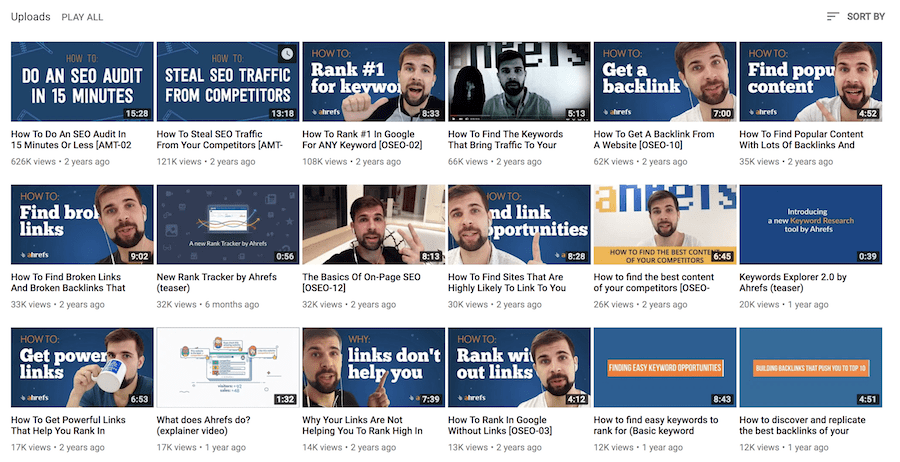
- Video Marketing: The Complete Guide
- The Distilled Guide To Online Video Marketing
- A Video Marketing Guide For Creating Epic Content
5. Hosting webinars
Webinars are basically online mini‐courses.
They can be great forms of content, especially if you are selling a digital product.
- The Step‐By‐Step Guide To Creating A Webinar That Sells
- Webinar Marketing 101
6. Content syndication
Content syndication is when a piece of web‐based content is republished (i.e. syndicated) by another website. Content syndication can be an excellent source of referral traffic.
- 4 Super‐Effective Content Syndication Strategies
- What Is Content Syndication and How Do I Get Started?
- Content Syndication: More Than A Traffic Boost
7. Podcasting
Content doesn’t need to be visual to be effective. Podcasting is an audible form of content that is excellent for brand building and growing an audience.
There are two major strategies when it comes to podcasting:
- Start your own podcast;
- Appear on someone else’s podcast.
Both strategies can be very effective at marketing your business online and building relevant industry relationships.
- How To Podcast: The Ultimate Guide To Podcasting
- How To Start A Successful Podcast
- The Ultimate Guide To Pitching Podcasts
- How To Get Interview On Top Podcasts In Your Industry
- 12 Best Podcasts to Master SEO and Stay Tuned
Email Marketing
Email marketing is super powerful because it is a direct channel of communication between your business and current and potential customers.
It starts by somehow acquiring your customer or potential customers email address. But then you have to figure out exactly how to market to everyone on your list…without spamming them.
Here are the tactics you can use to do this:
1. Lead magnets
You can’t market via email without your recipient’s email address. The easiest way to get your hands on some emails is through a lead magnet.
Lead‐magnets are something of value that you give away in return for an email address.
Here’s an example from VideoFruit—it’s located right after the blog post introduction:
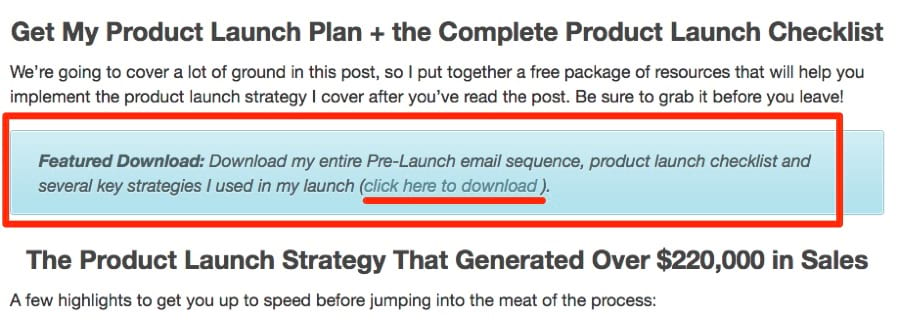
And here’s what you see when you click the link:

You’re asked for your email address in exchange for the “free” download.
Here are a few other examples of effective lead magnets:
- In‐depth guide/report;
- Free training;
- Free resource list;
- Discount code/coupon;
- Cheat sheets;
- Videos.
The key here is that the lead magnet is actually valuable and related to the product or service that you sell.
- The Ultimate Guide To Creating Killer Lead Magnets
- How To Create A Lead Magnet
- Lead Magnets: The Definitive Guide For Bloggers
Aside from lead magnets check out these simple ways to get more email subscribers.
2. Segmentation
Once you obtain the opt‐in, your goal with email is usually two things:
- Nurture the lead into a sale (or an upsell);
- Build brand awareness and authority.
To do this well, you’ll want to segment your email lists so you can send more targeted, personalized emails.
- Segmenting Email Subscribers
- How to Segment Email Lists for More Opens, Click‐Throughs, and Conversions
- 50 Smart Ways To Segment Your Email List Like A Pro
3. A/B testing emails
Now that you have your email list segmented out, it’s time for split testing.
Split testing (or A/B testing) just means you are testing different conversion elements against each other to see which your audience responds best to.
Here are a few examples of elements within an email you would run A/B testing on:
- Subject line;
- Content;
- Email “hook” (i.e., the first sentence or paragraph);
- Design element (e.g. color, layout, length, etc.)
- A/B Test Your Email Marketing: How to Get Started, What to Test, and 20+ Apps to Help
- A/B Test Your Email Marketing
4. Automation
Email marketing automation is the final piece of the puzzle and will save you a ton of time.
Basically, once your lead magnet rewards you with an opt-in—and you’ve segmented your list—you can build out automated lead nurturing email campaigns and run your email marketing on autopilot.
These are effectively pre‐made drip sequences that are sent out automatically by your email marketing software.
It’s even possible to send different emails based on subscriber interactions (e.g. email opens, link clicks, website visits, etc.)…all on autopilot.
- 4 Steps To Awesome Email Automation
- 13 Email Workflows You Should Be Using in Your Marketing Automation
- How To Build An Automated Email Marketing Machine (In 1 Hour)
Also, check the email marketing tools on our list of 101 marketing tools.
Search Engine Optimization (SEO)
Here is Google’s definition of search engine optimization (SEO):
The process of maximizing the number of visitors to a particular website by ensuring that the site appears high on the list of results returned by a search engine.
If you want organic search traffic to your website, you need to optimize for search. SEO can seem complicated and confusing, but the basics are easy enough to learn.
If you want to establish a firm understanding of SEO, check out this article. Otherwise, below are the core concepts of search engine optimization.
1. Keyword/topical research
You need to know what people are searching for before you can optimize for that search.
Keyword and topical research help you find those search queries and topics.
- How To Do Keyword Research for SEO — Ahrefs’ Guide
- Long Tail Keywords: how to get TONS of traffic from ‘unpopular’ search queries
- 4 Ways to Find Untapped Keyword Ideas With Great Traffic Potential
2. On‐page SEO
On‐page SEO refers to optimizing the content and HTML elements on a webpage. When you write content for your website, you want that content to have the best chance at ranking in search engines as possible.
- On‐Page Ranking Factors
- Anatomy of a Perfectly Optimized Page
At Ahrefs, we also conducted an on‐page SEO study. This contains some valuable insights and is well worth a read.
3. Off‐page SEO
Off‐page SEO helps improve your search engine rankings through tactics that aren’t implemented on your website.
When most people talk about off‐page SEO, they are referring to link building, but off‐page SEO can also include things like building citations and promoting content via social media.
- The Noob Friendly Guide To Link Building
- Off‐Page SEO: What It Is and How to Crack It
- Link Building Strategies That Work
4. Technical SEO
Technical SEO refers to non‐content related techniques that make it easier for search engines to crawl and index your website.
Technical SEO usually starts with a technical SEO audit.
- A 16‐Step SEO Audit Process To Boost Your Google Rankings
- Step‐By‐Step Technical SEO Checklist
- Technical SEO Audit Checklist For Human Beings
You can also check out the Ahrefs Site Audit tool to look for a number of technical SEO issues your website could be experiencing.
Conversion Rate Optimization
Marketing is all about getting that conversion. That’s why you do it in the first place.
So why not do things to increase conversions? That’s the basis of what is called conversion rate optimization (CRO).
CRO can be thought of as a combination of UI/UX (user interface/user experience) and copywriting. You use copywriting to deliver the message you are trying to convey and then you use design elements (UI/UX) to make it easy for the visitor to accomplish their goals and convert.
- The Beginner’s Guide To Conversion Rate Optimization (Qualaroo)
- The Beginner’s Guide To Conversion Rate Optimization (CXL)
Now for some basic conversion rate optimization strategies…
1. Conversion‐focused web design
Web design is where conversion rate optimization starts. Sorry, but if your site looks like it was built in 2001 (like the 2001 Wikipedia screenshot below), you are going to struggle to get anyone to convert.
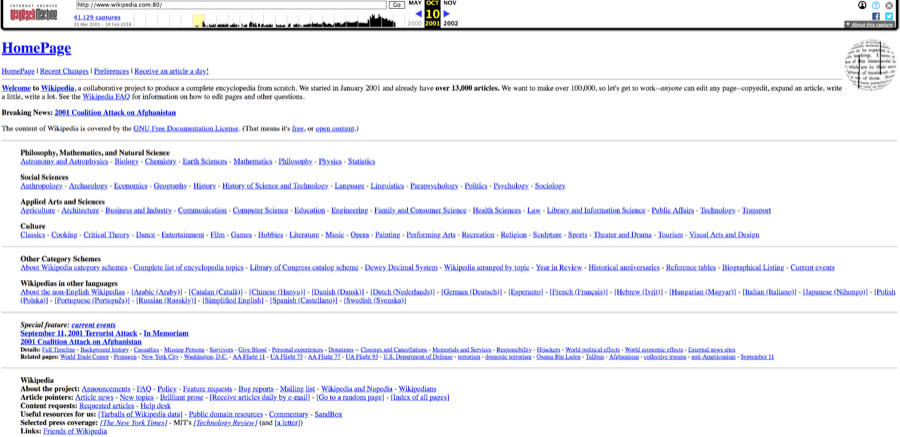
You want people to trust your website. Here are some examples of how to do that:
- Modern design;
- Testimonials;
- Reviews;
- Contact information;
- Logos of trusted companies you work with;
- Social trust signals (e.g. displayed follower counts, etc.)
- Want To Win Fights With Your Web Designer? Use These CRO Tactics
- The Anatomy of a Website that’s Optimized for Conversions
2. Headline optimization
Whether you are optimizing for organic search, pay‐per‐click advertising, display advertising, or something else, improving your headline is one of the easiest and highest ROI activities you can do.
To come up with your initial headline, see what your competition is doing and then do something similar. You can also use a tool like the Coschedule Headline Analyzer to tweak your first headline.
Once you have your first headline, it’s time to start testing other headlines. Here are a few guides on headline optimization and how to go about testing:
- How BuzzFeed, R29, and Other Top Publishers Optimize Their Headlines and Images
- 7 Things We Learned From 31 Days of A/B Headline Testing
- Set Up Your First A/B Test For Free Using Google Analytics Experiments
3. Call‐to‐actions (CTAs)
Your CTA (or call‐to‐action) is your best opportunity to tell a visitor on your website what action they should take and why they should take it. Netflix’s homepage is a great example of a simple, yet effective call‐to‐action.
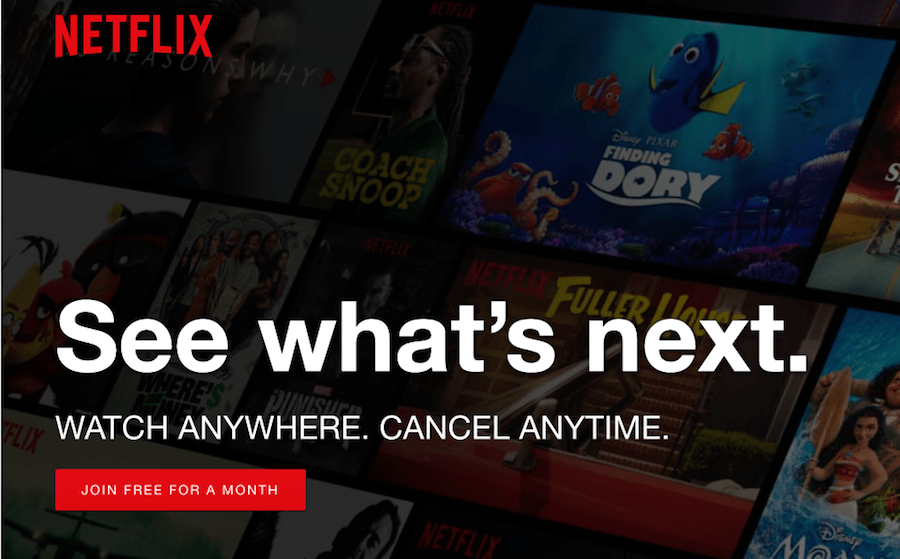
- Where to Put Your Call‐to‐Actions Buttons? What the Research Says About CTAs
4. Social proof
Social proof is the idea that consumers are more likely to convert when certain trust signals (e.g. social media followers/likes, testimonials, reviews, trust icons, etc.) are present.
- Social Proof: What It Is, Why It Works and How to Use It
5. A/B testing (for UI/UX elements)
Should you use a blue button or red button? Should the button be in the middle of the screen or to the right? A/B testing, also known as split testing, is how you answer these questions.
- A Guide To A/B Testing With Google Analytics
- How To Run An A/B Test In Google Analytics
Social Media
In this day and age, social media marketing is a well‐known internet marketing strategy.
But there is a misconception with social media that the whole goal is visibility with your current audience. This isn’t always true.
Sure, social media is a great way to communicate with your current audience, but visibility and communication are not enough to grow a brand or business. You need people to share your stuff with their friends (and friends of friends, and friends of friends of friends)!
But how do you get your current followers to share your brand or business with their followers…? Content! Really, really freaking good content.
- How To Develop A Winning Social Media Content Strategy (Free Template)
- A Video Marketing Guide On Creating Epic Content for Facebook, Snapchat, Twitter, and More
- 10 Tools For Creating Compelling Content For Social Media
- How To Go Viral On Social Media
And here are a couple of individual social media tactics:
1. Choose the right channel
Don’t advertise on Pinterest if you are trying to reach an older male audience. You won’t see results. Why? Well, Pinterest is mostly female.
Before you start spending time marketing via social media, make sure you choose a marketing channel your audience is on.
- How to Choose the Best Social Media Channels for Your Business
2. Social listening
You may not think of social media as a customer service tool, but it is one of the best out there.
Managing your reputation through an active social presence can save your business from negative press, or can increase positive hype your business could be experiencing.
- Social Listening: What It Is, Why You Should Care, And How To Do It Well
- A Beginner’s Guide To Social Listening
- What Is Social Listening and Why Is It Important?
Paid Advertising
Sometimes in marketing, you need to pay to play.
Paid advertising is where you pay a third‐party to advertise on the ad space they own.
Some of the more well‐known are Google Adwords and Facebook’s advertising platform, but there are many of them you can test out.
Most marketing channels take time before they start generating you a profit, but the beautiful thing about paid advertising is that it can provide an immediate return.
Below you will learn about some of the more well‐known paid advertising platforms.
1. Google Adwords
Google Adwords is a form of paid advertising, also known as pay‐per‐click (PPC), where you pay every time someone clicks on your advertisement shown on either Google’s Search or Display Network.
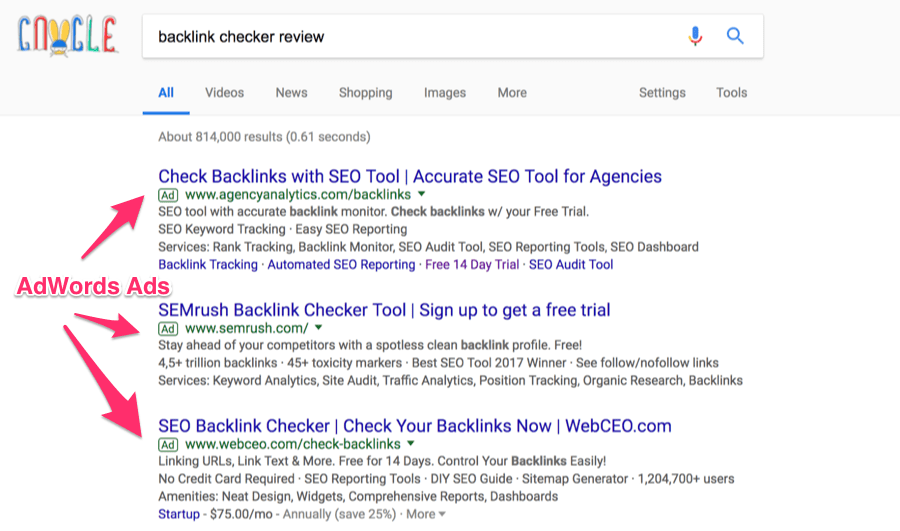
AdWords can be extremely powerful in driving targeted traffic to your website(s) or landing page(s).
- Social Listening: What It Is, Why You Should Care, And How To Do It Well
- A Beginner’s Guide To Social Listening
- What Is Social Listening and Why Is It Important?
2. YouTube advertising
YouTube has over 1 billion users with over 1 billion hours watched daily. I’m just going to let that sink in for a minute…
That’s a LOT of people you can reach with YouTube advertising.
- The Ultimate YouTube Advertising Guide
- How to Launch & Optimize a YouTube Video Advertising Campaign
- The Crazy Egg Guide To YouTube Advertising
3. Facebook advertising
Facebook advertising is known to be an effective and inexpensive form of digital advertising. When it comes to internet marketing strategies, Facebook ads will usually be one of the first few strategies mentioned because of how well they currently perform (when done right).

- Facebook’s Ad Guide
- The Complete, Always‐Updated Guide to Facebook Advertising
- The Beginner’s Guide To Facebook Advertising
4. LinkedIn advertising
LinkedIn advertising is another form of digital advertising similar to Facebook ads but is known for its effectiveness for B2B companies and marketers.
- LinkedIn Ads: A Comprehensive Guide For B2B Marketers
- The Crazy Egg Guide to LinkedIn Advertising
- LinkedIn Ads: Everything You Need to Know To Get Results
5. Programmatic advertising
Simply put, programmatic advertising is the purchasing of digital advertising space through a technology that automates the buying process. A demand‐side platform (DSP) is often the technology that the advertiser buys the digital ad placement through.
A DMP, or data management platform, is used to collect data and then analyze and segment it into audiences. These audiences are often fed to a DSP so more targeted ads can be delivered.
Programmatic advertising allows marketers to be strategic on how they spend their advertising budgets and are only getting better as the technology improves.
- Programmatic 101
- Programmatic Buying: Simple Guide To Get You Started
- Top 10 Demand Side Platform (DSP) For Programmatic Advertising
6. Retargeting
Here is Wikipedia’s definition of retargeting:
Behavioral retargeting (also known as behavioral remarketing, or simply, retargeting) is a form of online targeted advertising by which online advertising is targeted to consumers based on their previous Internet actions.
If someone lands on your website via a PPC ad and then leaves without purchasing, they could be gone forever. But if you have retargeting setup, you can continue to advertise to that person until they are ready to buy.
- The Ultimate Guide To Retargeting Ads
- Retargeting: The Ultimate Guide
- The Beginner’s Guide To Retargeting Campaigns
Influencer Marketing
Have you ever purchased a product because a friend recommended it? Definitely. What about a product from an infomercial? Not likely. But why is that?
You buy products recommended by friends because your friends have built up a certain level of credibility with you. You trust them because they are your friends. Influencer marketing is exactly the same.
According to Wikipedia, influencer marketing
is a form of marketing in which focus is placed on influential people rather than the target market as a whole. It identifies the individuals that have influence over potential buyers and orients marketing activities around these influencers.
- The Complete Guide to Influencer Marketing
- The Data‐Driven Marketer’s Guide to Influencer Marketing
Influencer marketing can have amazing effects on your business as long as one thing holds true… Your product has to be truly great. Tim says it best in his article on Medium, “a killer product is your best marketing strategy.”
Bringing it all together: digital marketing funnels (and measuring your results)
Whew…that’s a lot of strategies.
But how do you put all of these strategies together into a coherent plan that will generate ROI for your business?
Build a marketing funnel.
In reality, it’s very rare that a customer views an advertisement or visits your website for the first time and then immediately converts into a customer. It is almost always more complicated than that.
A marketing funnel takes someone from totally unaware of your brand, to lead, to customer.
Here is what a typical funnel looks like:
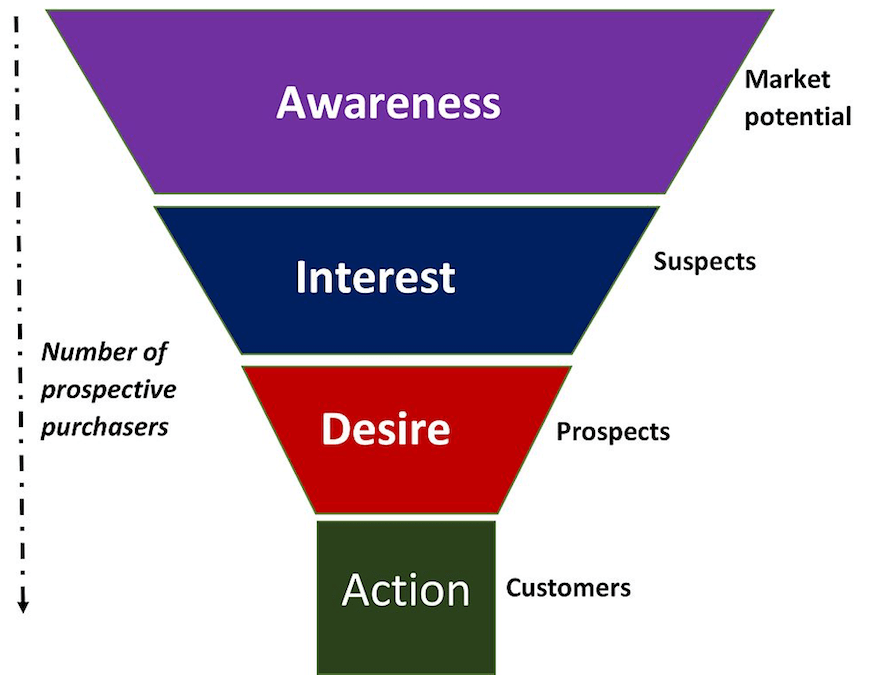
source: bluecorona.com
Basically, you use strategies like search engine optimization to pull people into the top of your funnel (awareness). Then email marketing, conversion rate optimization, etc to generate convert those people to leads (interest, desire). And finally, paid ads, retargeting, and so forth to convert leads into customers (action).
But here’s an important point: you don’t always have to build elaborate, super‐technical funnel. Sometimes a simple approach works best.
Here’s our entire email marketing funnel at Ahrefs, for example:
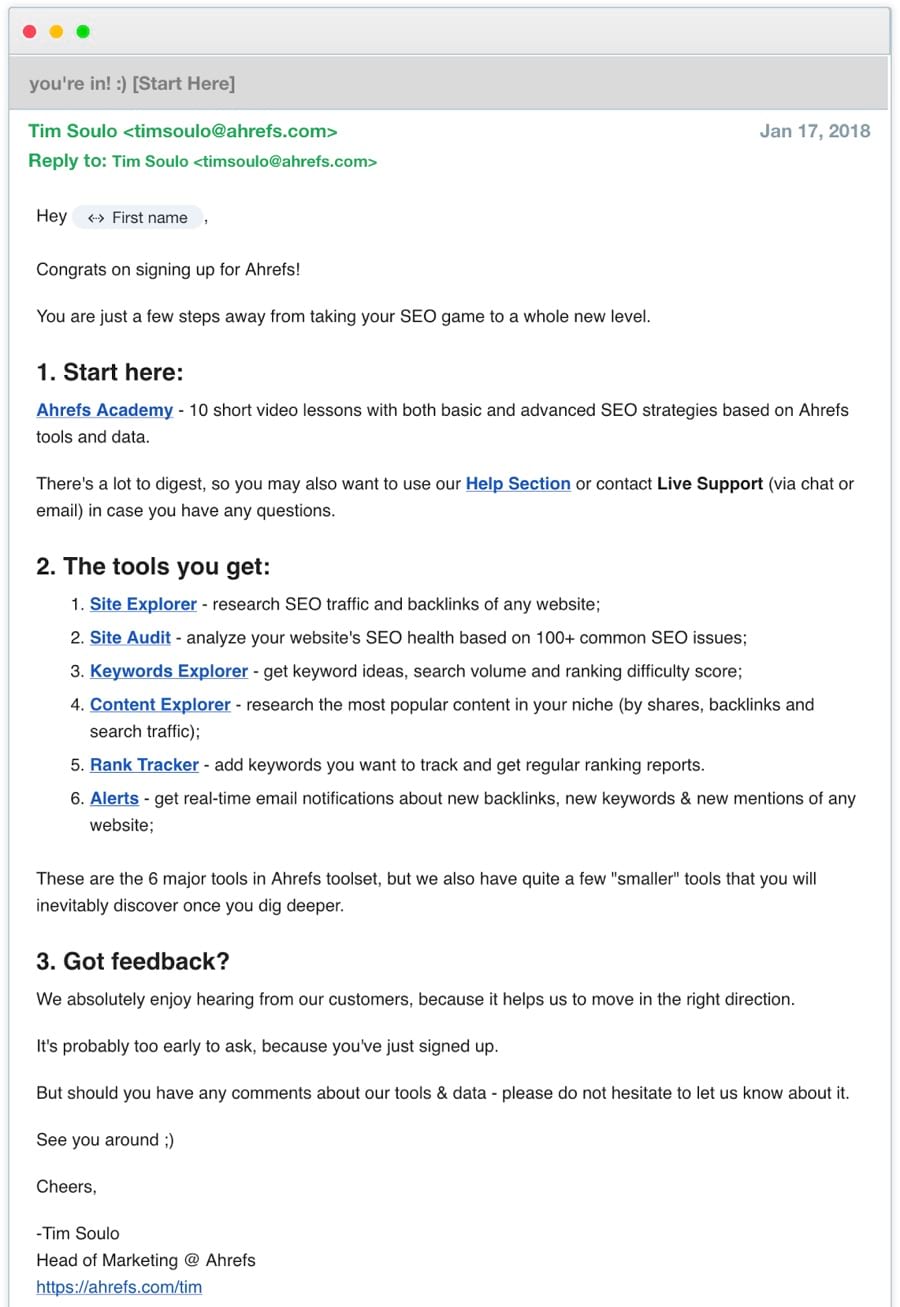
Yep, it’s one email. That’s it.
But this email helped us to grow our 8‐figure ARR by +65% last year.
- How I learned to stop worrying about my sales funnel (and embraced the unpredictable)
- How Marketing Funnels Work
- The Ultimate Guide To Creating Your Marketing Funnel
And remember, no matter which strategies/tactics you use (or don’t use), you should ALWAYS be measuring your success.
There are tons of tools you can use to do this. But the free tools from Google (i.e. Google Analytics, Google Search Console and Google Tag Manager) are enough for most people.
Conclusion
Nice work getting through that!
This list of internet marketing strategies is by no means comprehensive but should have educated you on some of the more timeless ones.
When executed correctly, the strategies listed throughout this post really work. And should continue to work.
The one caveat is that online marketing is constantly morphing and evolving. Nobody knows with a 100% certainty what strategies will be working ten years from now.
All you can do is constantly educate yourself so that you know what’s working now, and be aware of what’s on the horizon.
Write your favorite internet marketing strategy in the comments! I’m curious to see where the Ahrefs community is seeing their best results
Source
https://ahrefs.com/blog/internet-marketing-strategies/

